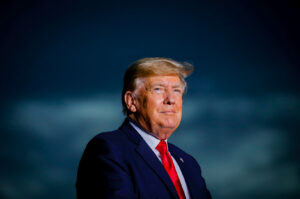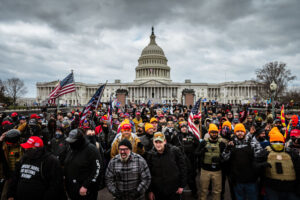Surely the white working class is to blame? It’s obvious that those who stormed the US Congress on January 6, 2021, were the very same people Hillary Clinton described as “the basket of deplorables”. They’re obviously racist, sexist and xenophobic. Why even bother checking?
Well, because it’s not quite as straightforward as that. According to the University of Chicago, 50% of the January 6 mutineers were either business owners or white-collar workers, and only 25% had no college degree.
Again and again, white working-class Americans have been slandered and cast as deranged MAGA fans in the national press. But the reality, as I reveal in my new book, is that Donald Trump’s most hardcore supporters are far wealthier and better educated than your ordinary American. The political scientists Noam Lupu and Nicholas Carnes have convincingly argued that only 30% of Trump voters in 2016 were white and working class.
The confusion partly stems from the misleading definition of “white working class”. The one widely used by pollsters and the media — “those without a four-year college degree” — is too simplistic. Many Americans without college degrees are financially better off than graduates; of the 2,600 top CEOs in America, 8% have no college degree. And while there are approximately 87 million working people in the US who have not finished college, almost a quarter of them are business owners, not workers. How could these bosses be in the same economic bracket as their employees?
We can get round this problem by tweaking the definition. In my research, I define the white working class as those who are in the bottom two-thirds of income distribution, and do not have four-year college degrees. The results have been quite extraordinary. I’ve found that, far from being a lost cause, this cohort has in fact become more liberal over the past several decades on key social issues concerning race, gender, LGBTQ+ rights, and immigration. A 1996 General Social Survey found that 59.8% of white working-class respondents thought that gay sex was always wrong; by 2021, that number plummeted to 29.3%. During this time, attitudes towards gay adoption also changed. An American National Election Studies (ANES) survey in 2000 found that only 38.2% of respondents agreed that gay and lesbian couples should be legally permitted to adopt children. By 2020, that figure had risen to 76%.
Why, then, is the media so quick to demonise America’s white working class? The idea that the working classes have a penchant for demagogues was popularised by the 20th-century sociologist Seymour Martin Lipset. In his influential article, “Democracy and Working-Class Authoritarianism” (1959), he claimed that “ethnic prejudices flow more naturally from the situation of the lower classes than from that of the middle and upper classes in modern industrial society”. He argued that working-class and agrarian populists tended to dislike “civil liberties for unpopular political groups, civil rights for ethnic minorities, legitimacy of opposition and proper limits on the power of national political leaders”.
When it came to explaining the rise of Senator Joseph McCarthy in the proudly working-class state of Wisconsin, Lipset’s essay appeared to have the answer: Wisconsin populists were clearly driven by “ethnic prejudices”. This view was gospel in the academic and political establishment until Michael P. Rogin, author of The Intellectuals and McCarthy (1969), deigned to look more closely at where the votes for McCarthy were cast. It turned out that working-class election districts voted against McCarthy. His real base of support came from small town professionals — the lawyers, business owners, and real-estate people who formed the traditional base of the Republic Party, especially in rural areas. The conservatives were in fact far more supportive of McCarthy’s assault on democracy than populist workers and agrarian progressives.
Today’s intellectuals have fallen into the same trap. Despite popular assumptions, Trump’s enablers consist of a vast horde of lawyers and businesspeople, similar to those who once supported Senator McCarthy. And then there are the media personalities and influencers who make their fortunes off the back of Trump’s success. In no way can these operatives be considered working-class.
Though white working-class Americans are often included in Trump’s photo ops, the archetypal MAGA face looks more like that of Rudy Giuliani, the former Mayor of New York City, who has shamelessly and repeatedly lied for Trump. MAGA definitely does not look like Shawn Fain, the president of the United Automobile Workers, who recently said that Trump has “a history of serving himself and standing for the billionaire class”.
Critics will say a majority of the white working class did vote for Trump, and that’s true. But then again so did a majority of the white managerial class. It’s hard to argue, then, that the white working class’s support of Trump is notable, much less exceptional. And in any case, most white workers are not attracted to Trump’s racist dog-whistles or even his anti-immigrant position, but rather they desperately hope that he might be able to bring jobs back to America and prevent theirs from vanishing. In fact, for the past few decades, white working-class Americans have been more likely to vote Republican if they live in a region affected by mass lay-offs and manufacturing decline.
And is this so surprising? In the eyes of many workers, the Democratic Party can no longer be trusted. The heirs of Franklin D. Roosevelt, whose New Deal catapulted many workers into the ranks of the middle class, have been unable to provide any serious protection against mass lay-offs — which have negatively affected more than half of all working people and their families. And since Bill Clinton’s election in 1992, the Democratic Party has been associated with Wall Street deregulation and international trade deals that have decimated jobs in the manufacturing sector.
All this time, working people have been waiting for a politician who dares to challenge corporate greed. But the failure of America’s two major parties to mitigate Wall Street’s war on workers has eroded their legitimacy. Increasingly, working people are giving up on politics, assuming that the system is rigged against them. And when a political system fails to provide even a semblance of job stability, democracy is inevitably vulnerable.
America’s politicians once understood this. In the Cold War, Washington successfully challenged communism by improving the standard of living of the working class. But since the fall of the Berlin Wall, the combination of rising inequality, mass layoffs, and the domination of financial economic interests has put an end to rising prosperity. And the result, as we’re now seeing, is worse than an embrace of MAGA — it’s the working-class rejection of politics altogether.
Disclaimer
Some of the posts we share are controversial and we do not necessarily agree with them in the whole extend. Sometimes we agree with the content or part of it but we do not agree with the narration or language. Nevertheless we find them somehow interesting, valuable and/or informative or we share them, because we strongly believe in freedom of speech, free press and journalism. We strongly encourage you to have a critical approach to all the content, do your own research and analysis to build your own opinion.
We would be glad to have your feedback.
Source: UnHerd Read the original article here: https://unherd.com/



